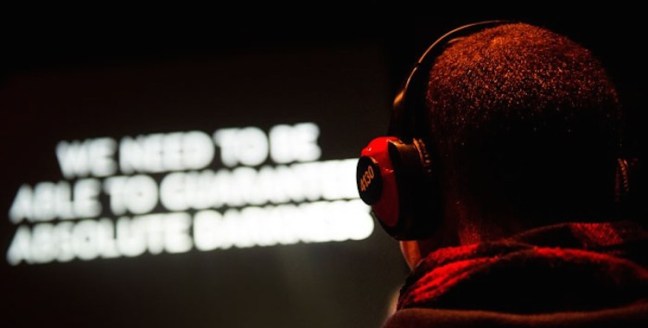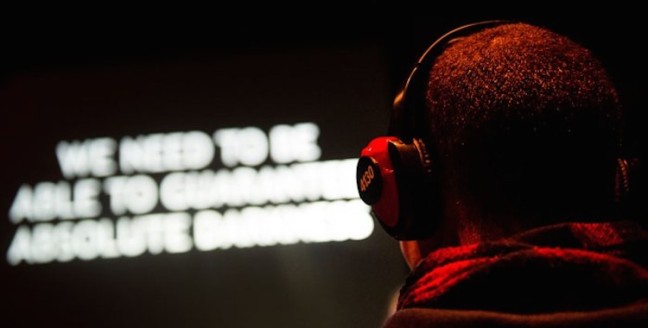Originally written for The Stage.
Binaural sound technology is nothing new. The technique of binaural recording, which creates the sensation of 3D sound for those listening through headphones, has been around in one form or another since the end of the 19th century, when it was used in the transmission of theatre and opera performances over telephone lines. What’s more novel, however, is its use in theatre.
Director David Rosenberg has long been aware of the potential of binaural sound. “I first came across it through my dad,” he remembers. “My dad was a physiologist working in the area of soundand he was doing work with binaural sound when I was about 10.”
The technology was not put to use in Rosenberg’s theatre-making, however, until he and sound designers Ben and Max Ringham started creating experimental scratch performances with theatre company Shunt, of which Rosenberg is a co-founder.
“Ben and I and David developed that interest together,” Max Ringham tells me, recalling their early experiments at the Shunt Lounge under London Bridge station in the mid-2000s. “First of all, we were working with an illegal radio transmitter and we would set up impromptu illegal radio stations to send audio out to people.” From these illegitimate beginnings, the trio gradually refined their use of the technology, eventually putting it to full use in the 2007 show Contains Violence at the Lyric Hammersmith.
In Contains Violence and subsequent shows Electric Hotel and Motorshow, Rosenberg explains that the use of binaural sound was “about trying somehow to bridge the visual gap between the audience and what they were watching”. In each piece, audience members were positioned as onlookers, with the sound pumped through their headphones immersing them in distant spaces, be those hotel rooms or car interiors.
But there are problems with this as a technique. “There’s a hierarchy of perceptions,” says Rosenberg, with sight at the top. “Sight occupies the very safe territory where lots of other sensations then attach themselves to what you see,” he continues, using the example of an experiment in which participants attributed different sounds to the same set of moving lips. “Sound is not a precise thing in the way vision is,” Ringham compares the two senses. “When you look at something you can see the clear relationship between a tree and a car, for example, whereas there’s an element of subjectivity with sound about where things are coming from.”
This explains why, for their latest experiments with binaural sound in Ring and Fiction, Rosenberg and his collaborators have plunged audiences into darkness.
“We wanted to completely change that hierarchy and have images created by the sound,” Rosenberg explains their thinking. “Deprived of other sensations, the audience become incredibly sensitive to the sound.”
Ring, created by Rosenberg, Ben and Max Ringham and writer Glen Neath, enveloped audiences in inky blackness and placed them at the centre of an unnerving aural experience. “With Ring, we were really looking at how to expand the role of the audience within this set-up and how to make them the subject of the piece,” says Rosenberg, “so they find themselves deeper and deeper within a performance that they have a role in, that they have a reason to be in.”
While audio performances often raise the question of what qualifies them as theatrical, it was this positioning of the audience that ensured that Ring remained a live experience and one that could not just be listened to at home. “The show for the audience is about being in a room full of people,” says Rosenberg. “You need to be in that situation in order for it to make sense.” Neath agrees, going as far as to claim that this work heightens the liveness of the theatre: “It feels like one of the most live experiences I’ve had in the theatre.”
Robbing the audience of their sight, meanwhile, has given greater scope for the sound. “The darkness is such a massive gift for us,” Ringham says. “It’s brilliant, because it means to start with everyone thinks you’re about 10 times better than you are. Your sense of hearing is so much more heightened in the dark and people’s focus is absolutely on what they’re hearing, because they have nothing else.”
As a sound designer, Ringham relishes the new opportunities that binaural technology allows. “The geek in me really enjoys throwing sounds around,” he says. He remembers a moment during Electric Hotel, in which the audio feed tricked audience members into believing that they could hear people speaking from among them. “Every night, watching 500 people turn around and look over their shoulder to see who was talking behind them when there was no one there, was quite a big thrill.”
Like any technological development, however, it has its challenges. “There are lots more facets to take on board when you’re trying to create it,” explains Neath, as well as lots of theatrical devices that are ruled out by the use of headphones and, in the cases of Ring and Fiction, the complete darkness. “There were so many things that you couldn’t do and you had to find a way round.”
Lessons have been learned along the way, such as the sound designers’ discovery that “people’s perception of things in a space has a limit; people can only hold three separate things in a 3D environment in their head and know where they’re coming from”. Ringham insists, therefore, that it’s important for theatre-makers working with this sound to keep it simple and not attempt to do too much at once. He also stresses that it’s “incredibly important” to use high-quality recording equipment in order to create the best experience. “There’s the KU100, which is the industry standard best and nothing sounds quite as good, to be honest.”
So what makes this technology so exciting for theatre-makers? “The main thing is a question of intimacy,” says Rosenberg. “With all live events we’re trying to create some sort of intimate relationship between the audience and what they’re seeing. How do you keep that intimacy when you have increasingly large audiences?” Binaural sound, which can create the sensation of a performer whispering directly into each and every audience member’s ear, is one answer.
Intimacy also seems to be the lure for audiences. Observing the growing interest in binaural sound across the theatre industry, Ringham suggests that “it’s more and more of interest to people as they’re more interested in an immersive type experience. It’s an incredible way of transporting people and putting them into different environments.”
This sensation of immersion is central to Fiction, the team’s second show using binaural sound and complete darkness. This time, the show puts audiences in two places at once: the room of the theatre, and the dream world that the sound transports them to. “The principal difference is that we’re taking the audience to a lot of different locations and there’s been quite a lot of discussion about how we actually record that,” says Ringham.
The effect of this sound, Neath hopes, is “something magical”, allowing audiences to suspend their disbelief even as they are made aware of the physical space they inhabit. “This is not real, but we challenge you not to believe it.”
Photo: Alex Brenner.

